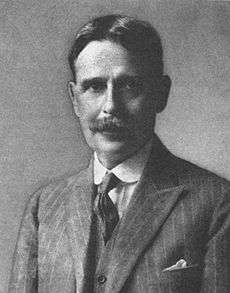Nelson Annandale

Thomas Nelson Annandale CIE FRSE (15 June 1876 in Edinburgh – 10 April 1924 in Calcutta) was a Scottish zoologist, entomologist, anthropologist, and herpetologist.
Life
The eldest son of Thomas Annandale, the regius professor of clinical surgery at the University of Edinburgh, Nelson was educated at Rugby School, Balliol College, Oxford, and the University of Edinburgh.[1]
Annandale went to India in 1904 as Deputy Superintendent of the Natural History Section of the Indian Museum. He was a deputy director at the Indian Museum in Calcutta and in 1907 he became its director, succeeding John Anderson (1833–1900). He had travelled widely before his career in India and with H. C. Robinson he had undertaken the Skeat Expedition to the northern part of the Malay Peninsula in 1899.[2]
He started the Records and Memoirs of the Indian Museum journals and in 1916, he became the first director of the Zoological Survey of India that he helped found. He was associated with many scientists of his time. This change placed an official equality with botany and geology and made more funds available for expeditions to various parts of India. He was interested in aspects beyond systematics including ecology. His suggestion of a problem in anthropology to P. C. Mahalanobis led to the latters discovery of a technique that developed into the multivariate statistical techniques of today. He held the position of director until 1924 and was succeeded by Robert Beresford Seymour Sewell (1880–1964). He was president of the 1924 session of the Indian Science Congress.
In 1921, as his father had been, he was elected a Fellow of the Royal Society of Edinburgh.[3] The Royal Asiatic Society of Bengal, with which he was closely associated during his service in India as Anthropological Secretary, Vice-President and as its President in 1923 instituted a triennial an Annandale Memorial Medal for contributions to anthropology in Asia. The first award was made to Dr Fritz Sarasin in 1928.
His insect and spider collection is in the Indian Museum, Calcutta.
He was also noted for his work on the biology and anthropology of the Faroe Islands and Iceland about which he published The Faeroes and Iceland: a Study in Island Life in 1905.[4]
Working in the scientific field of herpetology, he described several new species of lizards.[5]
Bibliography
| Wikisource has original works written by or about: Thomas Nelson Annandale |
(incomplete)
- Annandale N. & Robinson H. C. (1903). Fasciculi Malayenses: Anthropological and Zoological Results of an Expedition to Perak and the Siamese Malay States. Liverpool.
- Annandale N. (1905).The Faroes and Iceland: studies in island life. Oxford:Clarendon Press.
- Annandale N. & Gravely F. H. (1914). "The limestone caves of Burma and the Malay Peninsula, Part II: The fauna of the caves". Journal and Proceedings of the Asiatic Society of Bengal (ns)9(10) for 1913: 402-423.
- Annandale N., Prashad B. & Amin-ud-Din (1921). "The Aquatic and Amphibious Molluscs of Manipur". Records of the Indian Museum 22(4): 528-632.
References
- ↑ Dover, Cedric (26 April 1924). "Obituary - Dr. Nelson Annandale, C.I.E.". Nature. 113 (2843): 615–615. doi:10.1038/113615a0.
- ↑ Smith, M.A. 1941. The Fauna of British India, Ceylon and Burma, Including the Whole of the Indo-Chinese Sub-region. Reptilia and Amphibia. Secretary of State for India. (Taylor and Francis, Printers.) London.
- ↑ "FORMER FELLOWS OF THE ROYAL SOCIETY OF EDINBURGH. 1783-2002" (PDF). Royal Society of Edinburgh. Retrieved 3 December 2014.
- ↑ Annandale TN (1905) The Faroes and Iceland : studies in island life Scan
- ↑ Annandale at the Reptile Database. http://reptile-database.reptarium,cz/advanced_search?author=Annandale&submit=Search.
Further reading
- Hora, Sunder Lal (1949) In memoriam Proceedings of the Indian Academy of Science, Section A 8:157
- Anon. 1925: [Annandale, T. N.] J. Bombay Nat. Hist. Soc. 30 213-214.
- Calvert, P. P. 1924 [Annandale, T. N.] Ent. News 35:264.
- Evenhuis, N. L. 1997 *Litteratura taxonomica dipterorum (1758-1930). Volume 1 (A-K); Volume 2 (L-Z). Leiden, Backhuys Publishers.
- Kemp, S. W. 1925 [Annandale, T. N.] Rec. Indian Mus. , Calcutta. 27:1-28
External links
- Works by Nelson Annandale at Project Gutenberg
- Works by or about Nelson Annandale at Internet Archive